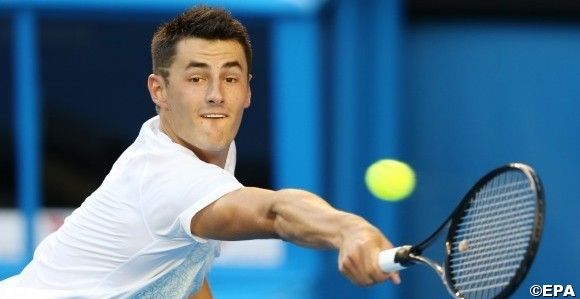Post-Australian blues? Waiting for Roland Garros and the red clay
 Post-Australian blues? Waiting for Roland Garros and the red clay
Post-Australian blues? Waiting for Roland Garros and the red clay epa03543907 Bernard Tomic of Australia in action during his match against Roger Federer of Switzerland, round three of the Australian Open tennis tournament in Melbourne, Australia, 19 January 2013. EPA/DAVID CROSLING AUSTRALIA AND NEW ZEALAND OUT |
By: E. Billett
As the tennis season eases through the latter half of February, the Australian Open suddenly seems a long time ago, and the next major event at Roland Garros seems an equally distant prospect. Though the Australian Open’s conclusion was somewhat anti-climactic in comparison with the previous year’s (what could possibly follow Nadal and Djokovic’s epic and not seem anticlimactic?), there was plenty of drama to be had – Azarenka and Li Na’s up and down final (in a literal sense for Li Na), and Wawrinka and Djokovic’s terrific 4th round battle being lauded by many as match of the year so far.
Being the regular provider of such excitement in recent years (the place of Azarenka’s maiden slam, Nadal’s 2009 semi final and final against Verdasco and Federer respectively, to name but a few), and the relative distance of the French Open, it is not surprising that the period just following the year’s first major can often feel like a post-Australian lull. However, whilst tennis fans and players alike look toward the clay courts of Paris and first ATP 1000 tournaments of the year, this year’s post-Australian period should not be overlooked, with significant developments for both the rising talents and established icons of the tour. Let’s start with the new.
On the men’s side, much touted talents have finally started to produce the results to match their promise. After a poor end to 2012, in which Tomic earned the unfortunate moniker of ‘Tomic the tank engine’ for his displays at the US open against Andy Roddick, the young Australian has made a very promising start to 2013, beating Djokovic in the Hopman cup and winning his first tour title in Sydney.
Tomic’s most recent result was, coincidentally, losing a close match in Rotterdam to another young star in the form Grigor Dimitrov. Like Tomic, Dimitrov has had a similarly bright start to the year, reaching his first tour final in Brisbane, where he fell to Murray, and after disappointing first round exits in the Australian Open and Sydney, he reached the semi finals in Rotterdam before losing to Del Potro. It is, interestingly, the first tournament in which Dimitrov has gone deeper than Federer, with whom he is often compared, possessing a remarkably similar fluidity in his style of play, and an equally stylish single handed backhand – perhaps an early a sign of changes to come.
The post-Australian period has also been significant for the well established players on tour – perhaps most significant for two of the highest profile players in today’s game. Despite losing the Qatar Open final to Azarenka, Serena Williams has become the oldest ever female world number one, proving that in major events, she is still the player to beat. It’s a remarkable achievement, competing at the highest level for over a decade, as she first became world number one in July 2002.
For a huge proportion of fans, however, the post-Australian period has been about one thing: the return of Rafael Nadal after a seven month injury hiatus. Despite losing to Zeballos in the final of the VTR Open, signs are encouraging for Nadal. Whilst his movement (understandably) is visibly not up to the standards of early 2012, and he appears to lack ‘match fitness’ in terms of shot selection at crucial junctures, the energy Nadal brings to the court, and his on court popularity is very much still present – something that the game has undeniably missed for the last half a year. Not only this, but Nadal’s return can also be seen as beneficial to the sport in general – helping to correct the imbalance that is felt at the major tournaments when one quarter of the draw is unoccupied by one of the ‘big four’. The post-Australian period has seen Nadal back to winning titles, defeating the seasoned veteran Nalbandian the Brazil Open final, which, for the sport, is only a good thing.
Topics: Australian Open, Bernard Tomic, Li Na, Novak Djokovic, Rafael Nadal, Roland Garros, Serena Williams, Sports, Tennis News, Victoria Azarenka


10sBalls Top Stories
- Reasons Behind the Increase in Sex Shops
- Reasons Behind the Increase in Sex Shops
- Reasons Behind the Increase in Sex Shops
- Casibom: Yaşayan Casinolar ve Bahisler Lider Platform
- Sea Star Casino: Play Games Without Registering Online
- JETZT DEN SWEET BONANZA SLOT GRATIS DREHEN
- Азартные игры с Мостбет Казино – испытайте удачу
- Çevrimiçi en iyi yuvalar: Hizmetinizde Karavan Bet Casino
- Top No Deposit Free Spins Offer for Canadians – December 2024
- Abe Bet Casino: Ücretsiz dönüşlerle heyecan hissedin
- Ünlü slotlar çevrimiçi kumarhanelerde başarı bet giriş ücretli formatta
- BasariBet Casino Giriş – En Güzel Canlı Casino Oyunlarına Katılın
- Игра на деньги в казино 1вин казино: безопасность
- De parking de credits sans oublier les Diction Casino Archive sauf que Perception
- Играть в хитовые слоты в надежных клубах azino777




